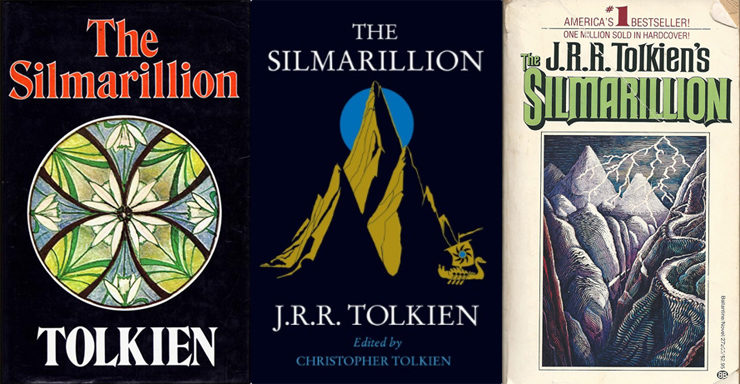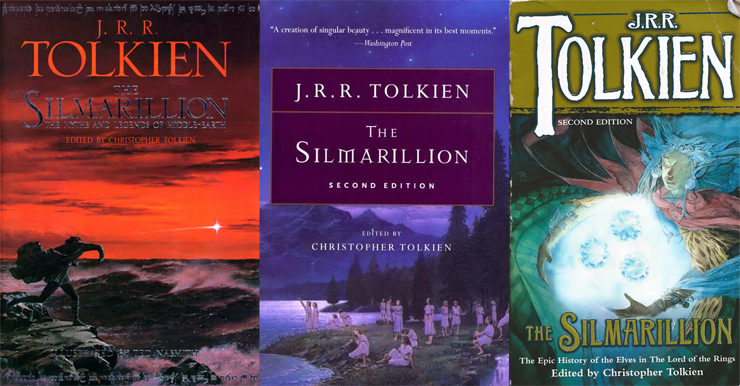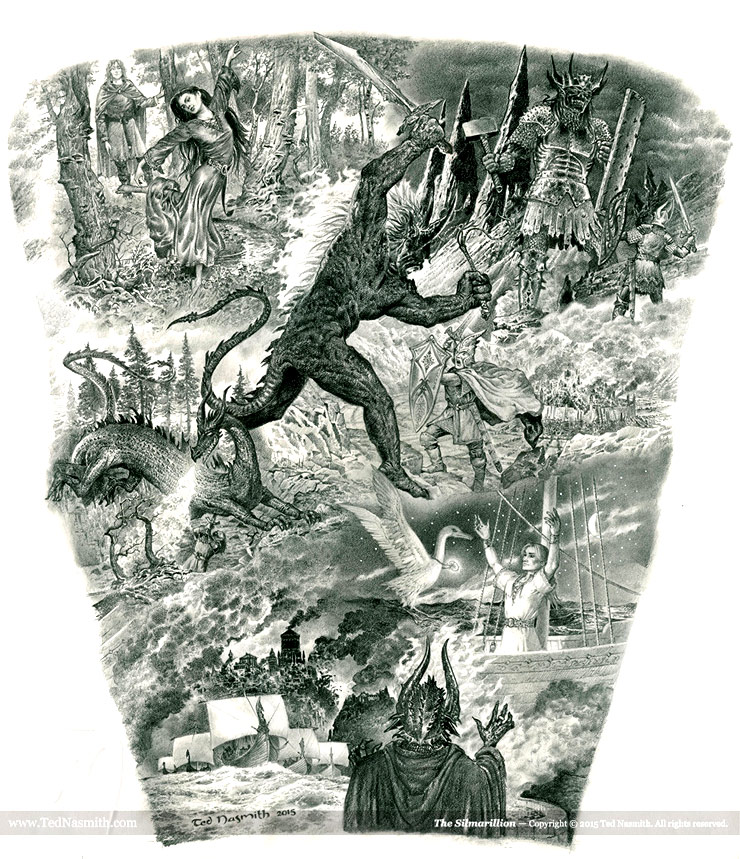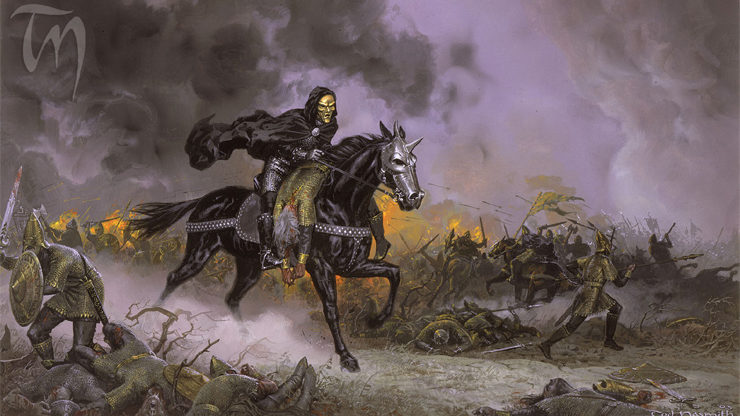Welcome to the Silmarillion Primer, wherein I discuss, praise, and adoringly poke fun at J.R.R. Tolkien’s seminal work in a series of essays, spanning twenty or so installments, as a prep for its would-be readers. I’d warn you that there will be spoilers, but honestly, spoilers just aren’t a thing to the good professor and he sure wouldn’t have cared (hey man, Frodo lives!). But more on that later.
They are old swords, very old swords of the High Elves of the West, my kin. They were made in Gondolin for the Goblin-wars…. This, Thorin, the runes name Orcrist, the Goblin-cleaver in the ancient tongue of Gondolin; it was a famous blade. This, Gandalf, was Glamdring, Foe-hammer that the king of Gondolin once wore.
Thus spoke Elrond in 1937’s The Hobbit, which turned eighty years old this week. He name-dropped Gondolin again in 1954’s The Fellowship of the Ring. Yet it would be another twenty-three years before J.R.R. Tolkien’s readers got the full story of that ancient Elven city and the other previously-alluded-to mysteries of the Elder Days. And so very much more.
The Silmarillion, a text Tolkien had been working on most of his life, is a hot mess of a masterpiece. Even in its vast world-building brilliance, it is merely, as he called it, “a compilation, a compendious narrative, made long afterwards from sources of great diversity,” and it’s essentially Middle-earth’s origin story. Fans of his legendarium owe much to Christopher Tolkien for bringing it all together, since his father did not live to see it completed himself. In fact, after The Hobbit’s success, Tolkien pitched The Silmarillion to his publisher but they rejected it almost on principle, since they really just wanted more hobbit stories.
But he never gave up, never stopped working on it. After his death, and presented with his father’s august but many-layered and often inconsistent drafts and notes, Christopher had his work cut out for him. As he explains in the Foreword:
I set myself therefore to work out a single text, selecting and arranging in such a way as seemed to me to produce the most coherent and internally self-consistent narrative.
And what a narrative it is! Anyone who’s tackled The Silmarillion at least once can tell you that it can be intimidating. There’s no question. Some who have attempted to read it have called it boring, dry, “a slog.” The language is often archaic, the chronology less than intuitive, the timescale enormous; and the character and place names are hilariously legion. But those who’ve made it through, especially those who’ve gone back to read it again out of sheer love for the world and its lore, know what a treasure trove it really becomes. I say becomes because you can miss a lot on the first (or second, or even tenth) go-round. Then, of course, to many of us it’s anything but boring. What starts as a stumbling block, that rich language, becomes as poetry—half the story is the art of language itself.

To be sure, The Silmarillion is not a novel in the way we’re used to; it doesn’t resemble The Lord of the Rings very much in structure or even style, except perhaps in dialogue. It’s more like fantastic nonfiction, or like a history book that might be shelved in the library of Rivendell. Yet even the historical bits are interspersed with novel-like segments. The narrative often pans out—way out—offering a god’s-eye-view of all existence and spanning huge swaths of time in just a few passages, then at unexpected moments slows down, zooms in close, and observes the very words and manners of its heroes and villains.
My answer to the challenge posed by this seemingly ancient tome is this very Primer. I’ll help you weave through the lofty language and highlight the names most worth remembering. This is not a reread or a thorough analysis of the text, nor a mere summary or recap. (There are some excellent places to find those out there already.) This is—for lack of a better word—a prelude or pre-read aimed primarily at casual Tolkien fans who want to know more. I hope to convince you to dive deep into its “dim waters of the pathless sea,” walk its treacherous and “clashing hills of ice,” and defy its “dark nets of strangling gloom” with me. Fair warning: the reading may get long, for these are “far journeys in search of the secrets of land and water and all living things.”
In my humble opinion, The Silmarillion is fantasy of the highest order, a great drama unfolding beneath the “wheeling fires” of the universe and set “in the Deeps of Time and in the midst of innumerable stars,” a world simultaneously like and unlike our own. And for those of you who are familiar with Tolkien’s creation myths already—those who have seen the light of the Trees—I hope this will be a fun refresher for you.
The Silmarillion is many things, and contains an almost incalculable number of themes, lessons, and beautiful/astonishing/terrible characters. But if I had to really boil it down to its bones, I’d say it’s this: the story of a world wrought by an omniscient and flawless Creator with the help of many flawed sub-creators who are wise but not all-knowing. Despite the book’s sumptuous yet daunting language and larger-than-life heroes, it’s imbued with all-too-familiar patterns of human behavior—even in its nonhumans. There’s always this perception floating around that Tolkien’s world is black and white, that his good guys are all goody-two-shoes, that his villains are too simplistically evil. And I can kind of see where this idea comes from in The Lord of the Rings, even if I disagree, but my immediate reaction to that is always: “Oh, they probably haven’t read The Silmarillion, then.”
Sure, The Silmarillion has its share of virtuous Aragorns and Faramirs and it definitely has its dominate-everyone-LOL Sauron types (including actual Sauron), but most of its characters wade through a murky spectrum of honor, pride, loyalty, and greed. Heroes fall into evil, good guys turn against each other, high-born kings turn out to be dicks, and powerful spirits tempted by evil may either repent of it or double down. It’s all there.
Oh, and lest I forget: The Silmarillion features fantasy literature’s most epic of jewel heists. Hell, the whole thing is a string of gem thefts. The titular gemstones, the Silmarils, are both like and unlike the One Ring we know and love. They’re coveted by pretty much everyone and inspire some truly dastardly deeds, yet they are of somewhat divine origin. Not intrinsically corrupting like Sauron’s ring, they do not possess the malice of their maker, and in fact are hallowed, scorching “anything of evil will” that touches them. In Tolkien’s world, the Silmarils are both MacGuffins and Chekhovian guns. Off the page, they motivate people to run around and do what they do; on the page, you know at some point someone’s going to get burned. Or stabbed. Or slashed. Or have something bitten off. It happens.
And that’s The Silmarillion for you. It’s all shining gems, flashing swords, whips of flame, foul dragon reek, and blood-soaked earth. It has more tragedies than victories, more sorrow than joy, but because it was written by a man of self-conscious faith, it also packs a few eucatastrophic punches. So chin up, good readers: the body count is high, but the payoff is glorious.

Tolkien, by the way, didn’t give a warg’s ass about spoilers. As a culture, we’ve become overly sensitive to the concept in recent years. When I read or hear discussions of Tolkien’s books, I still sometimes hear the “spoiler alert” expression, used either in observance or mockery of this modern day craze. But neither Tolkien nor his son had any such sensitivity. In his Foreword to the Second Edition of The Lord of the Rings, Tolkien casually refers to Sauron’s annihilation at the end. If you wanted to keep from knowing certain plot developments in this book, you’re kind of out of luck. He’s going to “spoil” them for you, and once you start to pick up on this tendency, it gets downright humorous—never mind how many appear in the chapter titles themselves. Anyway, if you didn’t already know that the One Ring indeed gets destroyed at the end of LotR, then I’m guessing you’re also not sure just yet about Luke Skywalker’s parentage, who Keyser Söze is, or why Snape is such a jerk to Harry Potter the whole the time. Oh, and the walrus was Paul.
One thing a reader might wonder once they dive into The Silmarillion is: Whose account is this exactly? Is the narrator both objective and omniscient? Sometimes it feels distinctly like an Elf’s point of view. Well, it’s lightly implied in the LotR Prologue, then later supported by Tolkien himself in notes and letters, that within Middle-earth, the Baggins’s Red Book of the Westmarch—which details the events of The Hobbit and The Lord of the Rings as written by the hobbits—also includes Elvish legends of old, which means some or all of the events detailed in The Silmarillion. Alternatively, consider this excerpt from Morgoth’s Ring (Vol 10 of The History of Middle-earth), wherein Christopher Tolkien shares more of his father’s behind-the-scenes intel:
What we have in ‘Silmarillion’ etc. are traditions . . . handed on by Men in Númenor and later in Middle-earth (Arnor and Gondor); but already far back—from the first association of the Dúnedain and Elf-friends with the Eldar in Beleriand—blended and confused with their own Mannish myths and cosmic ideas.
In one possible version, the stories presented in The Silmarillion are told to Ælfwine, a mortal Man, by an Elf named Pengolodh. But even this “frame” story Tolkien was never quite committed to. Regardless, it’s largely written with an Elvish POV as passed down by mortals and translated by hobbits, and is perhaps characterized by their own imperfections.
If it even matters. Ultimately, the author is in the know, at times he or she is clearly omniscient, referring to character thoughts and events that no Elf would know without some secret intel from on high.

And all of this is mere myth, after all. But to Tolkien, myth was meaningful, illuminating, relevant. Much more can be said about his stance on fantasy and myth, much more, but…another time. For now, consider that now more than ever before, Tolkien’s fairy-stories can provide the perfect escape. Not from real life—because God knows, The Silmarillion has its share of anguish and mourning alongside its triumphs and joys. I mean, rather, escape from whatever keeps us from from keeping our heads: political cobwebs, social blinders, or whatever snake oil the profiteers of the modern world are peddling. Escape from whatever current discord troubles us.
Speaking of discord, the first installment of the Primer will discuss the Ainulindalë, the introductory creation myth chapter in The Silmarillion, on October 4th.
Jeff LaSala is a production editor and freelance writer who can’t leave Middle-earth well enough alone. He also wrote some sci-fi/fantasy books and now works for Tor Books.










